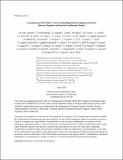Learning from Each Other: Cross-Cutting Diagnostic Development Activities Between Magnetic and Inertial Confinement Fusion
Author(s)
Gatu Johnson, Maria; Schlossberg, D.; Appelbe, B.; Ball, J.; Bitter, M.; Casey, D.T.; Celora, A.; Ceurvorst, L.; Chen, H.; Conroy, S.; Crilly, A.; Croci, G.; Dal Molin, A.; Delgado-Aparicio, L.; Efthimion, P.; Eriksson, B.; Eriksson, J.; Forrest, C.; Fry, C.; Frenje, Johan A.; Gao, L.; Geppert-Kleinrath, H.; Geppert-Kleinrath, V.; Gilson, E.; Heuer, P.V.; Hill, K.; Khater, H.; Kraus, F.; Laggner, F.; Lawrence, Y.; Mackie, S.; Meaney, K.; Milder, A.; Moore, A.; Nocente, M.; Pablant, N.; Panontin, E.; Rebai, M.; Reichelt, Benjamin L.; Reinke, M.; Rigamonti, D.; Ross, J.S.; Rubery, M.; Russell, L.; Tardocchi, M.; Tinguely, R. Alex; Wink, Christopher W.; ... Show more Show less
Download24ja072_full.pdf (654.5Kb)
Metadata
Show full item recordAbstract
Inertial and Magnetic Confinement Fusion (ICF and MCF) follow different paths toward goals that are largely common. In this paper, the claim is made that progress can be accelerated by learning from each other across the two fields. Examples of successful cross-community knowledge transfer are presented that highlight the gains from working together, specifically in the areas of high-resolution x-ray imaging spectroscopy and neutron spectrometry. Opportunities for near and mid-term collaboration are identified, including in Chemical Vapor Deposition (CVD) diamond detector technology, using gamma rays to monitor fusion gain, handling neutron-induced backgrounds and developing radiation hard technology, and collecting fundamental supporting data needed for diagnostic analysis. Fusion research is rapidly moving into the igniting and burning regimes, posing new opportunities and challenges for ICF and MCF diagnostics. This includes new physics to probe, such as alpha heating; increasingly harsher environmental conditions; and (in the slightly longer term) the need for new plant monitoring diagnostics. Substantial overlap is expected in all of these emerging areas, where joint development across the two subfields as well as between public and private researchers can be expected to speed up advancement for all.
Description
Submitted for publication in Review of Scientific Instruments
Date issued
2024-04Department
Massachusetts Institute of Technology. Plasma Science and Fusion CenterJournal
Review of Scientific Instruments
Publisher
AIP
Other identifiers
24ja072